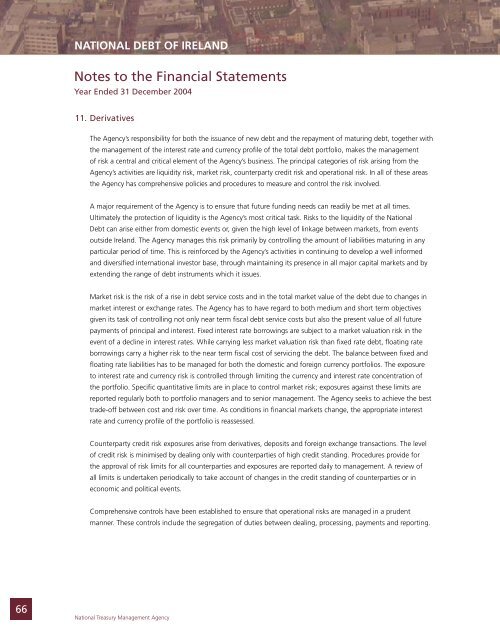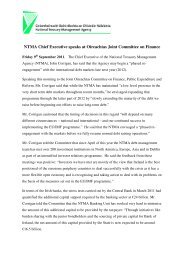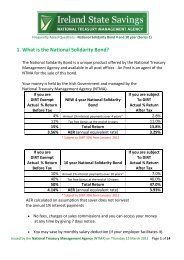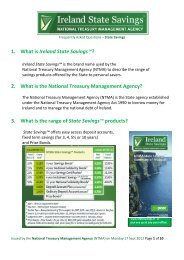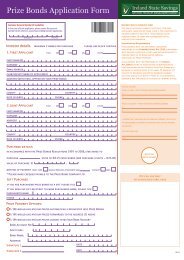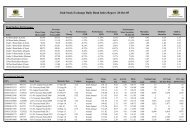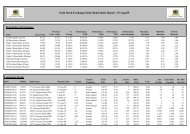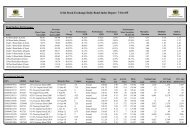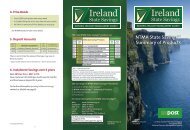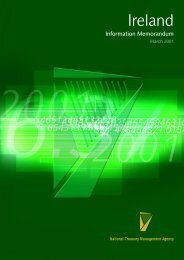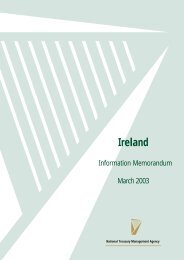Report & Financial Statements for the Year ended 31st December ...
Report & Financial Statements for the Year ended 31st December ...
Report & Financial Statements for the Year ended 31st December ...
Create successful ePaper yourself
Turn your PDF publications into a flip-book with our unique Google optimized e-Paper software.
NATIONAL DEBT OF IRELAND<br />
Notes to <strong>the</strong> <strong>Financial</strong> <strong>Statements</strong><br />
<strong>Year</strong> Ended 31 <strong>December</strong> 2004<br />
11. Derivatives<br />
The Agency’s responsibility <strong>for</strong> both <strong>the</strong> issuance of new debt and <strong>the</strong> repayment of maturing debt, toge<strong>the</strong>r with<br />
<strong>the</strong> management of <strong>the</strong> interest rate and currency profile of <strong>the</strong> total debt portfolio, makes <strong>the</strong> management<br />
of risk a central and critical element of <strong>the</strong> Agency’s business. The principal categories of risk arising from <strong>the</strong><br />
Agency’s activities are liquidity risk, market risk, counterparty credit risk and operational risk. In all of <strong>the</strong>se areas<br />
<strong>the</strong> Agency has comprehensive policies and procedures to measure and control <strong>the</strong> risk involved.<br />
A major requirement of <strong>the</strong> Agency is to ensure that future funding needs can readily be met at all times.<br />
Ultimately <strong>the</strong> protection of liquidity is <strong>the</strong> Agency’s most critical task. Risks to <strong>the</strong> liquidity of <strong>the</strong> National<br />
Debt can arise ei<strong>the</strong>r from domestic events or, given <strong>the</strong> high level of linkage between markets, from events<br />
outside Ireland. The Agency manages this risk primarily by controlling <strong>the</strong> amount of liabilities maturing in any<br />
particular period of time. This is rein<strong>for</strong>ced by <strong>the</strong> Agency’s activities in continuing to develop a well in<strong>for</strong>med<br />
and diversified international investor base, through maintaining its presence in all major capital markets and by<br />
extending <strong>the</strong> range of debt instruments which it issues.<br />
Market risk is <strong>the</strong> risk of a rise in debt service costs and in <strong>the</strong> total market value of <strong>the</strong> debt due to changes in<br />
market interest or exchange rates. The Agency has to have regard to both medium and short term objectives<br />
given its task of controlling not only near term fiscal debt service costs but also <strong>the</strong> present value of all future<br />
payments of principal and interest. Fixed interest rate borrowings are subject to a market valuation risk in <strong>the</strong><br />
event of a decline in interest rates. While carrying less market valuation risk than fixed rate debt, floating rate<br />
borrowings carry a higher risk to <strong>the</strong> near term fiscal cost of servicing <strong>the</strong> debt. The balance between fixed and<br />
floating rate liabilities has to be managed <strong>for</strong> both <strong>the</strong> domestic and <strong>for</strong>eign currency portfolios. The exposure<br />
to interest rate and currency risk is controlled through limiting <strong>the</strong> currency and interest rate concentration of<br />
<strong>the</strong> portfolio. Specific quantitative limits are in place to control market risk; exposures against <strong>the</strong>se limits are<br />
reported regularly both to portfolio managers and to senior management. The Agency seeks to achieve <strong>the</strong> best<br />
trade-off between cost and risk over time. As conditions in financial markets change, <strong>the</strong> appropriate interest<br />
rate and currency profile of <strong>the</strong> portfolio is reassessed.<br />
Counterparty credit risk exposures arise from derivatives, deposits and <strong>for</strong>eign exchange transactions. The level<br />
of credit risk is minimised by dealing only with counterparties of high credit standing. Procedures provide <strong>for</strong><br />
<strong>the</strong> approval of risk limits <strong>for</strong> all counterparties and exposures are reported daily to management. A review of<br />
all limits is undertaken periodically to take account of changes in <strong>the</strong> credit standing of counterparties or in<br />
economic and political events.<br />
Comprehensive controls have been established to ensure that operational risks are managed in a prudent<br />
manner. These controls include <strong>the</strong> segregation of duties between dealing, processing, payments and reporting.<br />
66<br />
National Treasury Management Agency


